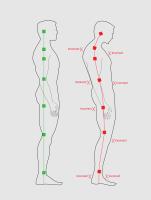 Add My Company
Add My Company
Sign In

So, what is good posture? Simply, good posture is good health. Good posture can also mean that your bones are properly aligned and so are your muscles, joints and ligaments. This allows them to work as nature intended. When you are in the right posture, it should feel almost effortless to maintain the position. This emphasising the importance of why staff should be educated with techniques to improve their posture.
Some of the advantages of good posture includes, the fact that it keeps bones and joints in the correct alignment this meaning that muscles are being used properly. As the bones are in a better alignment this ensures that there is less stress on these ligaments and means that your muscles will feel less fatigued due to them working more efficiently. This results in the body using less energy to ensure a good posture.
You will also find an increase in your ability to breathe properly when there is an increase in your posture. This may seem like a basic strength however it will lead to a huge increase in your concentration and thinking ability too. It is well documented that our brains require 20% of oxygen to do its job effectively. The more oxygen the brain receives, the more productive you will be. This can happen due to an increase in the amount in which we inhale due to our improved posture. A good posture leads to your ribs opening up so that there is more room for oxygen inhale.
Good posture will also improve your image. People whose joints are strong look smarter and come across as being more attractive. This results in a better body image as posture helps to make you feel more self-confident. It will also help to give you a level of assertiveness and appeal.
Health complications are easily avoided when you have a good posture. A bad posture leads to an increase in the risk of back aches, slipped disc, pressure inside your chest, back pain, poor blood circulation. All these
Just changing a few aspects in your everyday life will lead to an improvement in your posture. Some methods can include:
• Setting a reminder to check in on your posture.
• Having regular massages.
• Eliminating any bad habits which result in bad posture.
• Purchasing a high quality chair, with a firm low back support.
• Making sure both feet are grounded when either standing or sitting.
• Avoid carrying heavy items.
• Using a back cushion.
• Engaging in exercises, such as yoga, which will aid your flexibility.
These are all small changes which can result in a dramatic change in your posture.
Furthermore, it is crucial for staff to be educated on posture techniques, because posture performed poorly has many negative repercussions. All these will lead to a workforce which isn’t productive and will require more days off due to the decrease in their health.
Moreover, there will be a notable blood vessel constriction which will occur when your posture is bad, this happens because of the changes in the alignment of the spine. The constriction of the blood vessels around the spine can cut off blood supply to the cells of the muscles, which most importantly affects nutrient and oxygen supply. Blood vessel constriction can also raise your chances of clot formation and issues with deep vein thrombosis.
In addition, as well as the constriction of blood vessels, a nerve constriction will also occur. This happens because as the spine changes in shape, there is a movement which puts pressure on the surrounding spinal nerves. The nerves that connect to the spine come from all over the body, as a result these nerves will cause pain to all areas across the body not just the neck and back.
A study conducted by San Francisco State University, found that poor posture worsens depression and stress. The experiment found that when the body is slouched and constricted, it prevents the body working optimally which results in a bad mood. It will also found that staying in a seated position for an extended period of time, results in all your internal processes slowing down. This leads to an energy level decrease. When you’re slouching, your body is compressed and constricted meaning that your heart and lungs are having to work harder to pump blood and circulate oxygen. The main issue of this is that it causes stress on your internal organs and muscles.
Surprisingly, bad posture will also lead to digestive issues. When slouched, it’s not just your heart and lungs which are constricted, but it’s also your intestines which are in an uncomfortable position. This can make digestion uncomfortable and cause a host of issues. Slouching has even been attributed to digestive issues such as acid reflux and hernias.
Back, shoulder and neck pain are the most common effects of poor posture, and the most noticeable. Sitting in a slouched position at your desk for an extended period of time puts a great deal of stress on your upper body, especially if your body is not properly supported. It’s no shock to find that both the lower back and the neck are the two areas of the body which are most targeted by pain due to posture. Statistics have found that the lower back is targeted 63% and the neck at 53% due to bad posture. A study in 1999, found that sitting at an angle of 110-130 degrees is optimal for spine comfort, however another in 2007 showed that leaning back at 135 degrees is ideal for preventing back strain.
More often than not, poor posture is attributed to a poorly set up workstation. Desks and monitors may be too high or low, this being with chairs which may not provide adequate support and computer accessories may not be ergonomically designed for improved comfort. Changes required for a good posture are minimal, so it’s highly advised to focus on increasing your posture in any way possible. This will lead to a healthier body which functions effectively and productively.
For more information on Why educating staff in good posture techniques is so important? talk to Relaxa Posture Group
Enquire Now
More Blogs
List your company on FindTheNeedle.

